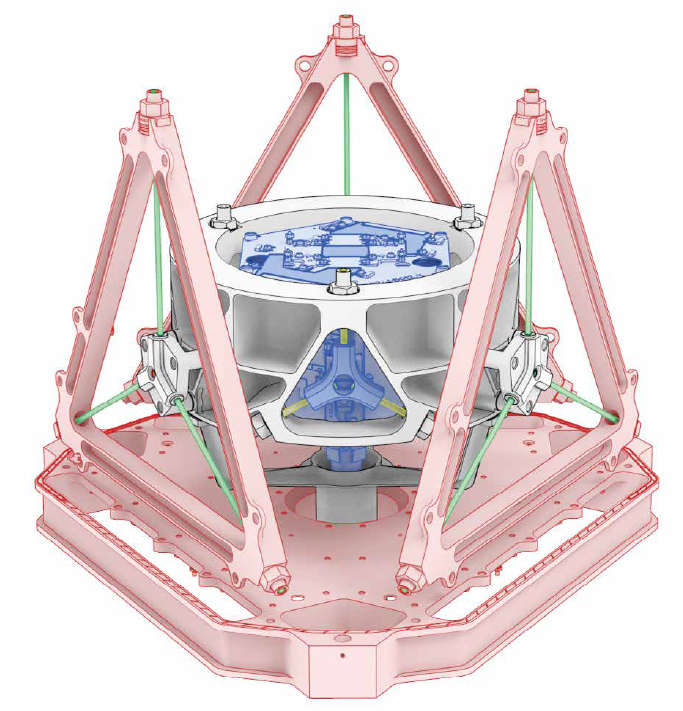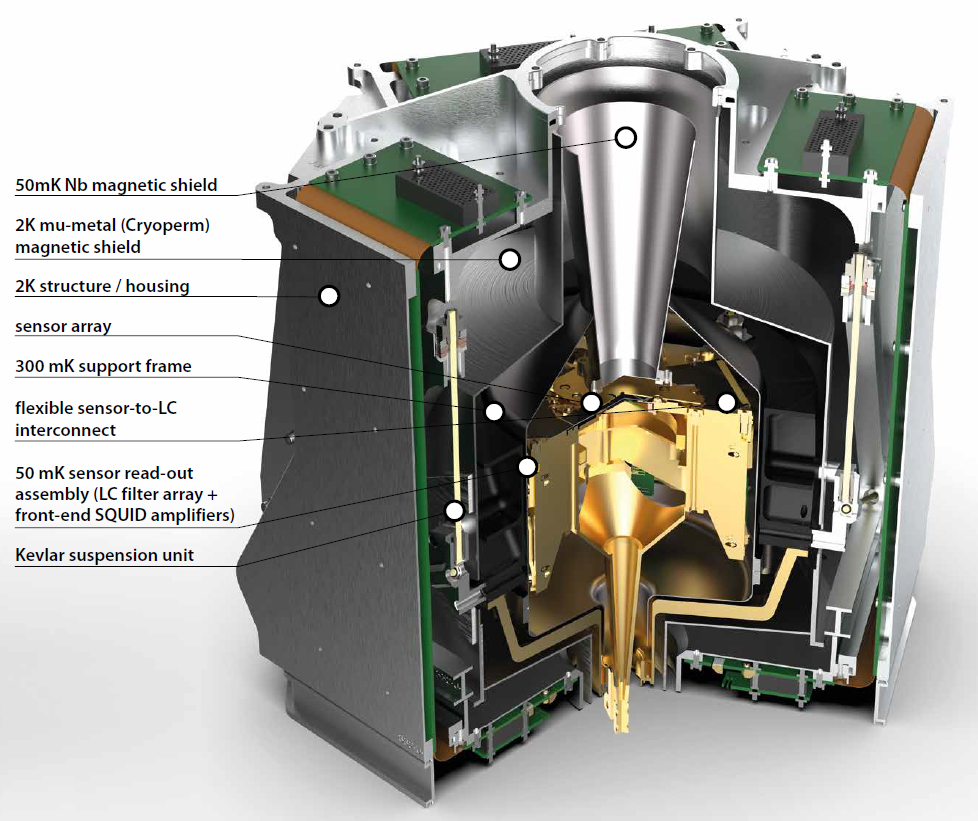SRON Netherlands Institute for Space Research participates in the development of the X-ray instrument X-IFU for the European space telescope Athena, which will be launched around 2030. Among other things, the SRON team is designing a Kevlar suspension to thermally isolate the camera and keep it in place. They wrote a popular-scientific article about it for Mikroniek.
Along with Hubble’s famous pictures taken in visible light, astronomers take photographs in many other parts of the radiation spectrum, such as in radio, infrared or X-rays. This enables them to see unique features of the universe that are invisible to even the largest optical telescope imaginable. By using X-rays, for example, we can observe active galactic nuclei (AGNs) spitting out jets of gas and hot glowing matter being eaten by black holes.
Since the Earth’s atmosphere absorbs X-rays, we need space telescopes to capture this dangerous but useful type of electromagnetic radiation. ESA, the European Space Agency, is currently developing X-ray satellite Athena (sci.esa.int/athena), to be launched around 2030. On-board will be two instruments: a Wide Field Imager (WFI) and an X-ray Integral Field Unit (X-IFU). In April 2018, SRON received a subsidy from NWO, the Dutch national research organisation, to participate in the development of the latter.
X-IFU will be the most sensitive X-ray space instrument ever developed. It will have a 2.5 eV spectral resolution, with 3,840 pixels of 0.25 cm x 0.25 mm, over a field of view of 5 arcminutes. To reach that level of sensitivity, it needs to be free of background noise at its operating temperature of 50 mK. This means that only low thermal conduction from the relatively warm telescope can be allowed, so the camera needs to be mounted using a string suspension.
As one would expect in a space mission, the camera’s parts are not just floating around in free space, hanging on a leash. To achieve the specified sensitivity the X-ray camera must be in a well-determined fixed position. In other words, SRON engineers must tighten the suspension strings firmly enough to ensure that the camera’s movement is only minimal. They have already found the right material to use: Kevlar, as it is both strong and has a low thermal conductivity. However, this still leaves some concerns.

Mechanical vibrations
The X-ray camera contains a cryostat to keep it cooled to below 50 mK. Like any refrigerator, cryostats are all about pumping gases around, inevitably leading to vibrations, which are then picked up by the strings, causing them to oscillate. This oscillation is one of the concerns, because these strings will in turn transfer vibrations to the camera. Also, the strings themselves will heat up from the oscillations, and this additional heat will also be absorbed by the camera. SRON engineers are faced with the challenge of minimising the transfer of vibrations to the Kevlar strings.
The more firmly the cords are tightened, the more they will pick up vibrations from the machine they are connected to. The camera is sensitive to thermal fluctuations of the cooler, because the pixels measure temperature increase due to X-ray absorption. For sufficiently accurate measurements, these fluctuations need to be smaller than 10-6 K. By separating the natural resonance frequencies of the two suspended stages (see Figure 1), the suspension can be made to act as a filter for vibrations, thereby minimizing the amount of heat that is generated in the suspension.
Launch
Any rocket launch goes hand-in-hand with enormous vibrations; in the case of the X-IFU, up to 12.7 grms. This makes tight strings good candidates for breaking. To survive the launch, the Kevlar cords need to be able to handle more force than the 2.5 kN tension that is needed for the thermal suspension. The design margin for the X-IFU instrument dictates a capacity of more than 5 kN, with a requirement that there should remain almost 2 kN of pretension at the moment of launch. This is where the practicalities of a real-life space mission come into play. Before launch we have to perform several functional tests, including some at cryogenic temperatures. During these cooling downs, the frames of the suspension contract while the Kevlar expands (due to its negative thermal expansion coefficient). The pretension will then decrease dramatically. To solve this issue, disc springs were designed to make sure that there is always pretension, even at the lowest temperatures.
End-fitting
To make something stronger, one must first secure the weakest link. In the Kevlar suspension, this is the end-fitting. To make it at least as strong as the Kevlar cord, the string filaments were untwisted at both ends and put in a hole injected with adhesive. Untwisting increases the total surface area of the Kevlar that is attached to the end-fitting. Furthermore, the hole was designed to have a conical shape, so when the cord is pulled, the adhesive is pulled into the conical hole and the grip tightens. In the end, 100 per cent of the Kevlar cord bulk strength was reached. SRON, together with NTS Mecon and funded by ESA, is developing a reliable and reproducible manufacturing and assembly process for these end-fittings.
18 possible failures
The camera is suspended at three points. Each of those is connected with an external framework by three Kevlar strings. This framework has three suspension points of its own, which again are connected to a framework by three Kevlar strings. This brings the total number of strings to 18 (2 x 3 x 3). Each string is a single-point failure: if one of them loses its pretension, then the entire mission is at risk. With one loose string, the launch loads will probably destroy the detector and/or a thermal shortcut could occur, making it impossible for the cooler to bring the detector to its operating temperature of 50 mK. This science mission is literally hanging by a thread.
Current status
So far, we have been able to manufacture end-fittings that are stronger than the Kevlar cord itself. We learned that this was not as easy as it may sound, as Kevlar cord is strong and difficult to get a grip on. The next steps, with NTS Mecon, are to develop a reproducible manufacturing and assembly process, incorporating end-fitting assemblies in a (dummy) suspension system and putting it to a vibration test to simulate the launch loads.
In parallel to this, next year SRON will build a development model of the Focal Plane Assembly (FPA), including the suspension system, to verify the performance of the camera system (Figure 2). For this, the FPA will be integrated into a cooler system, so that the influence of micro-vibrations will also be assessed. The development model will not be tested for launch (macro-) vibrations.



